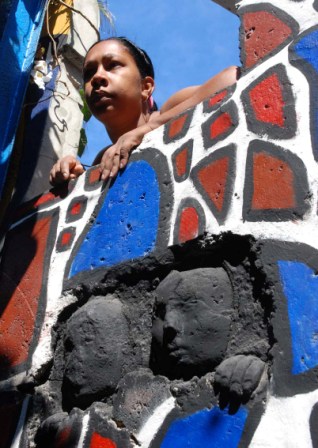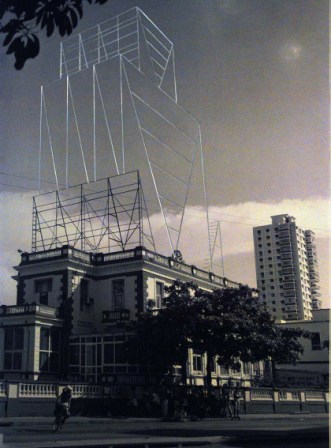Art in the Community
By Lucia Lopez Coll

HAVANA TIMES, June 8 (IPS) – At times we journalists need to assume a social role. I’m not talking about the responsibility to inform, an integral part of this profession, but rather the various services that we are frequently asked to give to those around us.
One of those is putting our personal libraries at the disposition of the public, especially in a neighborhood such as mine where you would have to take a city bus to get to the closest library. There’s always someone who figures that I probably have the book that the school asked their son or daughter to consult; then there’s the inveterate reader who comes wanting to borrow a good detective story.
When Cachita, my neighbor, helps her granddaughter with her homework and has doubts about how to spell a word, she doesn’t look it up in the dictionary. Instead, she picks up the phone to ask me if capacitación is spelled with a “c” or an “s”. Manolo, the one on the corner, needs to write a letter to request a change in workplace, so naturally he asks me to write it for him. And if there’s an amateur artist who needs some advice regarding how to get his work into the public eye, right away they run to knock on my door without thinking twice about it.
That’s exactly what happened a few days ago when an old colleague came to tell me about the project that his son, an aspiring photographer, was working on. The problem is that the boy doesn’t want to be the kind of photographer who takes pictures of fifteenth -coming of age- birthday parties and weddings; instead, he sees himself as an artist.
The project in question, as my neighbor explained – both proud and a little dubious of his son’s bright ideas – had to do with creating a photographic series on the neighborhood and the surrounding areas.
The idea left me a bit perplexed and unable to formulate an immediate opinion. We live in an isolated area on the periphery of the city, where there are only two buildings worth photographing. One is the current seat of the Havana Provincial People’s Power government, a sort of English castle from 1917, originally a wedding present from the tycoon Ernesto Sarro to his daughter Celia and son-in-law Octavio Averhoff; the other is an unusual building that has an enormous bust of Jose Marti on the top floor balcony.
“You see,” my colleague began to explain with a world of patience, “The thing is, he wants to do something like that artist in the Fine Arts Museum.”
“Which artist? Fabelo?” I asked, remembering the recent show “Survivors” by this important Cuban creator. For the tenth Havana Biennial Exhibition he presented us with some gigantic cockroaches with human heads crawling around the outside walls of the National Art Museum. It’s a work of great impact which leaves no visitor indifferent, even those who don’t really know how to value a work of art and have their picture taken with a foot on the body of one of the insects that lies on its back on the ground, in a pose suggestive of a hunter with his prized quarry.
Where Tourists Never Go, Even by Mistake
“No, not that,” he clarified, “the other exhibit inside.” He pulled out of his pocket a wrinkled piece of paper, reading it with difficulty. “Garaicoa, Carlos Garaicoa.” That brought to my mind the viewpoint proposed by this exhibitor in the Biennial. “The reform that’s inside of me,” which involves models, installations and photographs worked in with architectural codes. I especially recalled the photos which show skeletal billboards alongside or on Havana edifices with virtual modifications realized by the artist.
“Oh, now I know which one you’re talking about, but I still don’t understand what your son wants to do,” I said. So he explained to me that everyone talks about Old Havana and the conservation and restoration projects underway there, but no one thinks about the things that happen in this barrio where tourists never come, not even by mistake.
“What he wants to do is take pictures of all these places that are falling down piece by piece: the open drainage ditches, the stray dogs, the garbage piled up, and the drunks and crazy people wandering about. Maybe if he puts all of this together and sets up an exhibit somewhere, like perhaps the Municipal Cultural Center, then somebody will be receptive to our problems and something could be done. What do you think?”
I don’t know why my friend and his aspiring photographer son think that I should have an answer to their question. In the first place, I don’t know if the young man knows the difference between an amateur photo and an artistic one. In the second place, I don’t know anything about the Cultural Center’s undertakings, much less being sure that they would be well disposed to mounting an exhibition of this type.
In the course of thinking about this, I recalled another amateur photographer from the great movie Smoke who had spent the last 20 years of his life taking pictures of a corner of New York, his city. They were Polaroid photos, always taken from that same angle, so that the only variable was the people going past his lens. One day he shows his work to a friend who recognizes among the people an image of his wife who had died some years before.
Hoping to Have an Impact
The discovery is as unexpected to the character as it is impacting, although the rest of the world would see only a woman going by in the distance. It’s not a special picture or even one made with artistic ambitions, but its content provokes a strong reaction in the man who sees it because it speaks to him, it’s capable of communicating something to him.
Without a doubt, art possesses a certain ability to transmit ideas, awaken doubts, and induce reflection. But maybe my friend’s son expects too much to come from his pictures.
This all brings me back to the old discussion regarding the social function of art. While some specialists clamor for their purity and disconnection from the real world, others defend their intrinsic possibilities of educating, and to a certain extent influencing that reality, although many deny that poetry, film or visual arts can have a real transformative capacity.

Nevertheless, I assured the person I was talking with that the most important thing wasn’t that his son attain space in the Cultural Center. Rather, the important thing was the interest he had in photography and his desire to use it to say something. There’s also nothing wrong with the fact that he’s concerned about the problems he sees around him and wants to transmit these concerns to others. In contrast, there are many other young people in the neighborhood whose worlds revolve around raising pigeons, or whose favorite pastime is hanging out for hours on the corner watching the world go by.
Regarding the 10th Biennial Exhibition, I mentioned to him that one of its positive aspects has been the work of artists who, in very different ways, have managed awaken growing interest in the population through art projects immersed in their everyday surroundings. Some examples of this are the herd of (metal frame inflatable) elephants running through the city, done by Juan Emilio Fuentes, a sculptor from Granma province; or those huge boxes of juice abandoned in Plaza Vieja, the brain child of Victor Sanchez, with the intention of reminding us of our responsibility to the environment.
What’s more, in every new celebration of the event an area of the capital is selected in which to hold artistic presentations, with a very positive impact. During past exhibitions activities were realized in the Alamar suburb, in the houses of the neighbors themselves; there was a unique experience carried out in the district called La California with the participation of painters Diago, Manuel Mendive and Eduardo Roca (nicknamed Choco); and I recall the presentation of German, Brazilian and Cuban artists in the building and mural located on the corner of Cancha and Porvenir Streets, in support of the project “Making murals” that is going on in the Lawton municipality.
This year the LASA Contextual Art Project was held in the Havana municipality of La Lisa. The project was developed in San Agustin, and its artistic vision relates directly to real life with the active participation of the locals themselves.
I suspect that my friend is not very familiar with this topic and didn’t really know what I was referring to, but at any rate he got enthusiastic about the idea. He even made me promise to get him more information about LASA, initials that stand for the Artistic Laboratory of San Agustin. This is a project promoted by the painter Carlos Ariel Candelario to encourage the cultural life of the area and consolidate a sense of belonging amongst its inhabitants.
My friend seemed interested, and perhaps he is already picturing his son as the promoter of a similar activity in this neighborhood, although he thinks that nobody here is inspired by that sort of thing.
In the end, I didn’t want to dishearten him. I told him that his son’s photography project sounded like a wonderful idea to me and that he should encourage him to keep going. I could detect a shadow of doubt passing before his eyes, but I kept insisting. At times we journalists have a social role to fulfill.






I’m not sure how often the bloggers read the comments on this site. But, in terms of Photographers who do work similar to the project this young person would like to undertake I recommend checking out Camilo José Vergara. Vergara documents the decaying urban landscapes in the US, but the artist is also a sociologist and his photographs speak volumes about the “forgotten” slums and decaying factories of a few major American cities. Sebastiao Salgado is also very well known for his social documentary photography.